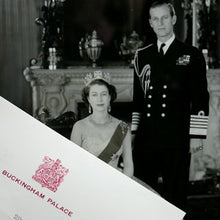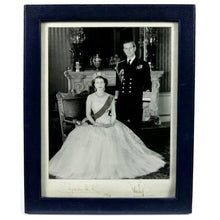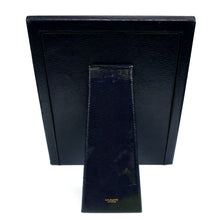Signed Royal Presentation Portrait of Elizabeth II and the Duke of Edinburgh, 1954
- Regular price
- £4,200
- Sale price
- £4,200
- Regular price
-
- Unit price
- /per
Adding product to your cart
Overall: 33cm (13in) x 25.5cm (10in)
Provenance: Captain J.S. ‘Fish’ Dalglish, CVO, RN, (1913-1995), Executive Officer and first Captain of HMY Britannia (1953-1954).
Black and white full length portrait photograph of the Queen and The Duke of Edinburgh, signed in the mount ‘Elizabeth R’ and ‘Philip’, and dated 1954. In easel backed navy blue morocco frame by HH Plante, Bury Street, St James’s, London. Together with two letters from Martin Charteris, Assistant Private Secretary to Elizabeth II - ‘The Queen has commanded me to send you this photograph, which Her Majesty and The Duke of Edinburgh have signed for you to commemorate your service in HM Yacht BRITANNIA’.
Read more

In April 1949 Dalglish was caught up in the Yangtse River Incident while serving as Fleet Gunnery Officer, Hong Kong. He was aboard HMS London en route to Shanghai when she went to the assistance of the frigate HMS Amethyst which had been fired on by Chinese Communist batteries suffering 17 killed and 10 wounded. As a staff officer Dalglish had no particular duties and was assigned to ‘A’ Turret as London advanced upstream with her battle ensigns flying. Long before reaching Amethyst, London came under heavy fire, as Dalglish later related: ‘the Communists opened fire at a range of less than a mile with solid armour-piercing (anti-tank) bullets and larger high explosive shells from field guns. London was a very big ship and difficult to miss at that close range, the former penetrated the ship like butter and the latter wreaked terrible damage... London opened fire with everything and I have little doubt that our 8-inch, 4-inch and pom-pom gunfire caused havoc ashore... Poor London was hit over 250 times! The turret I was in was put out of action by armour-piercing bullets severing the electric cables and then an H.E. hit on the turret roof flipped off one of the three armour plates and we were open to the sky! We were achieving nothing for Amethyst so we eventually turned in the river and retreated, with nineteen dead and many more wounded.’ The son of an Admiral, Captain Dalglish was commissioned from RNC Dartmouth in 1931. During the Second World War he served in the destroyer Faulknor in the North Sea and Mediterranean, and later in the Far East, participating in Operation Iceberg.








